-
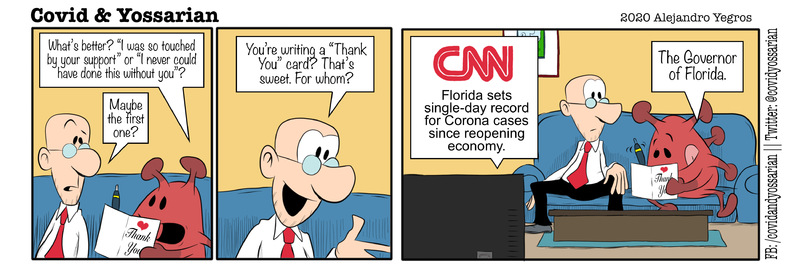
2020-06-08
A comic strip about Covid-19
-
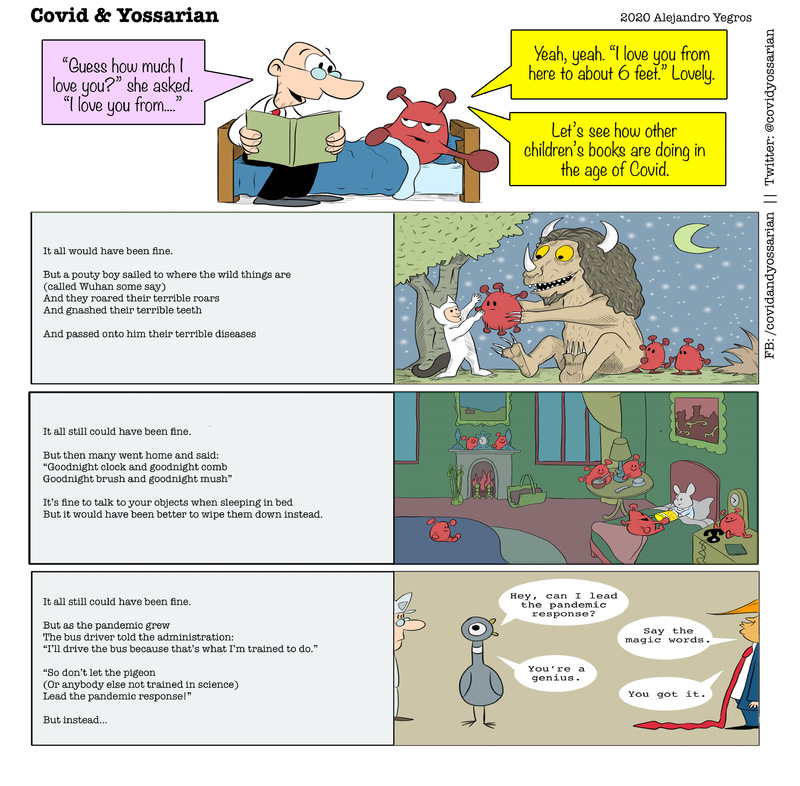
2020-06-07
A comic strip about Covid-19
-
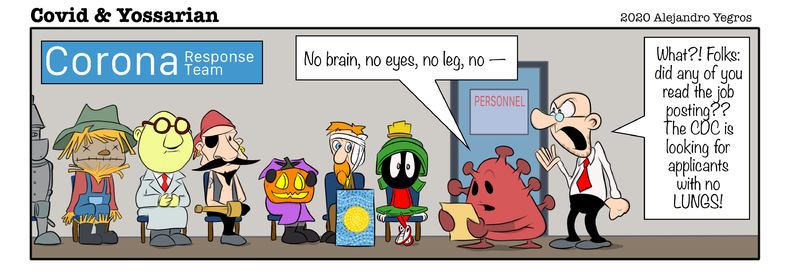
2020-06-06
A comic strip about Covid-19
-
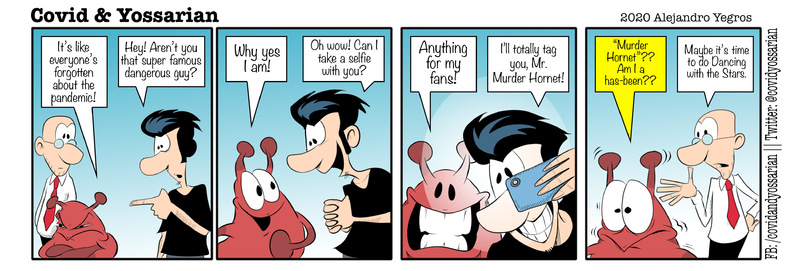
2020-06-05
A comic strip about Covid-19
-
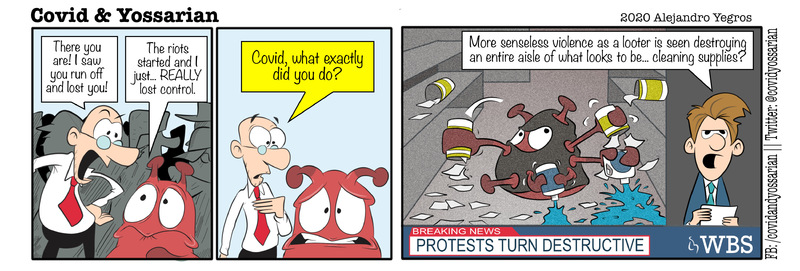
2020-06-04
A comic strip about Covid-19
-
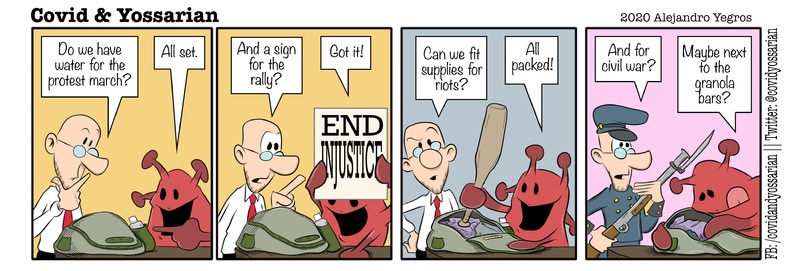
2020-05-03
A comic strip about Covid-19
-
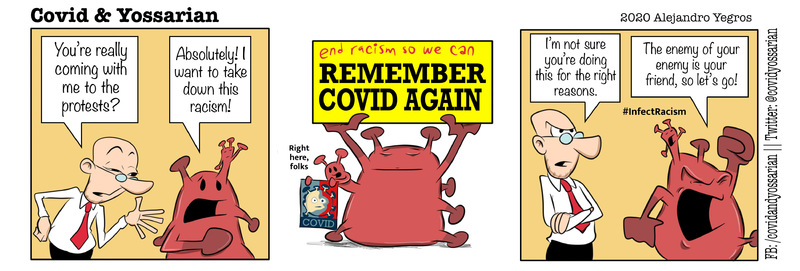
2020-06-02
A comic strip about Covid-19
-
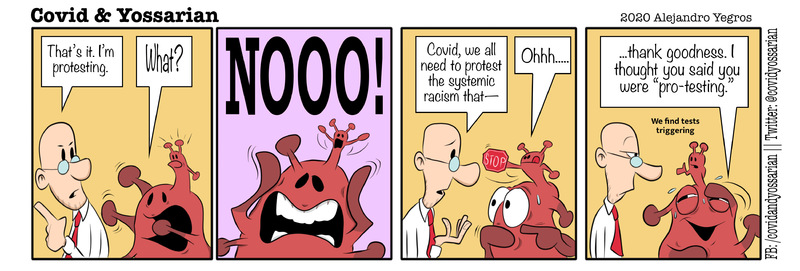
2020-06-01
A comic strip about Covid-19
-
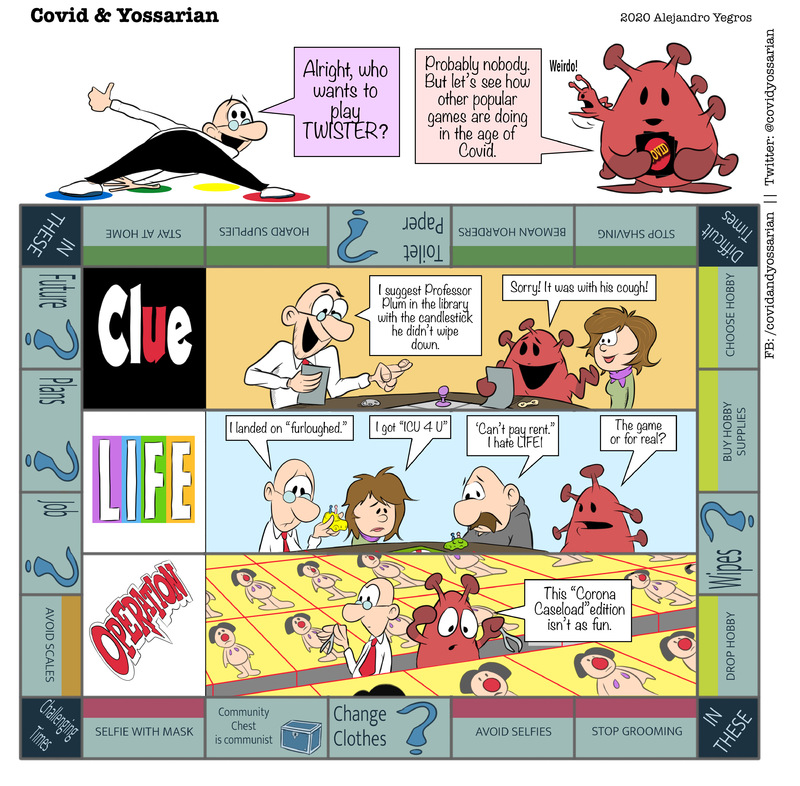
2020-05-31
A comic strip about Covid-19
-
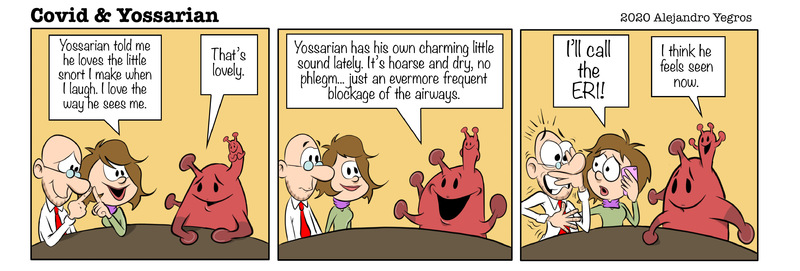
2020-05-30
Covid and Yossarian Episode 74, Covid and Yossarian Episode 8
-
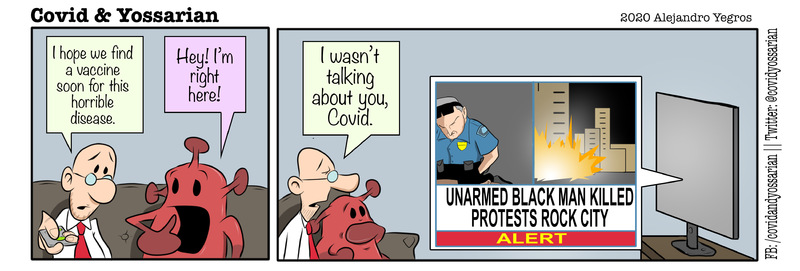
2020-05-29
A comic strip about Covid-19
-

2020-05-28
A comic strip about Covid-19
-
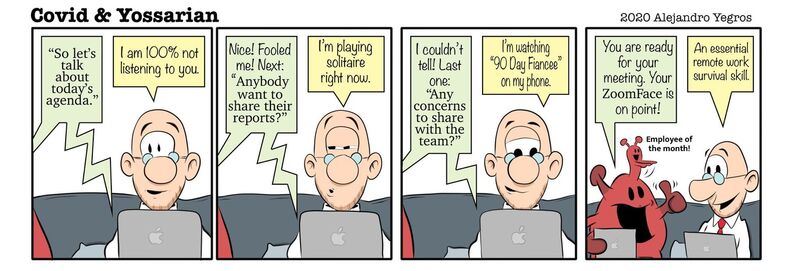
2020-05-27
comic about covid
-
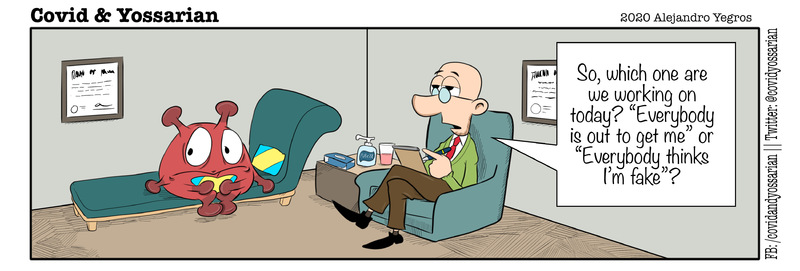
2020-05-26
comic about covid
-
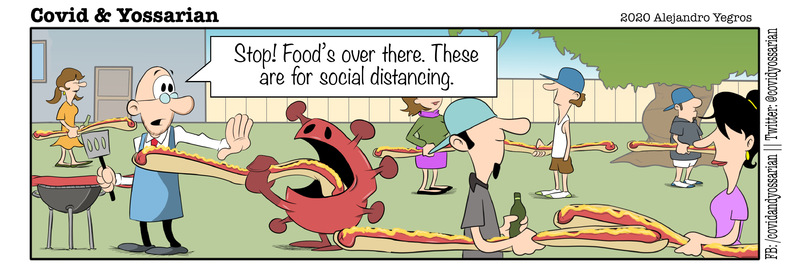
2020-05-25
A comic strip about Covid-19
-
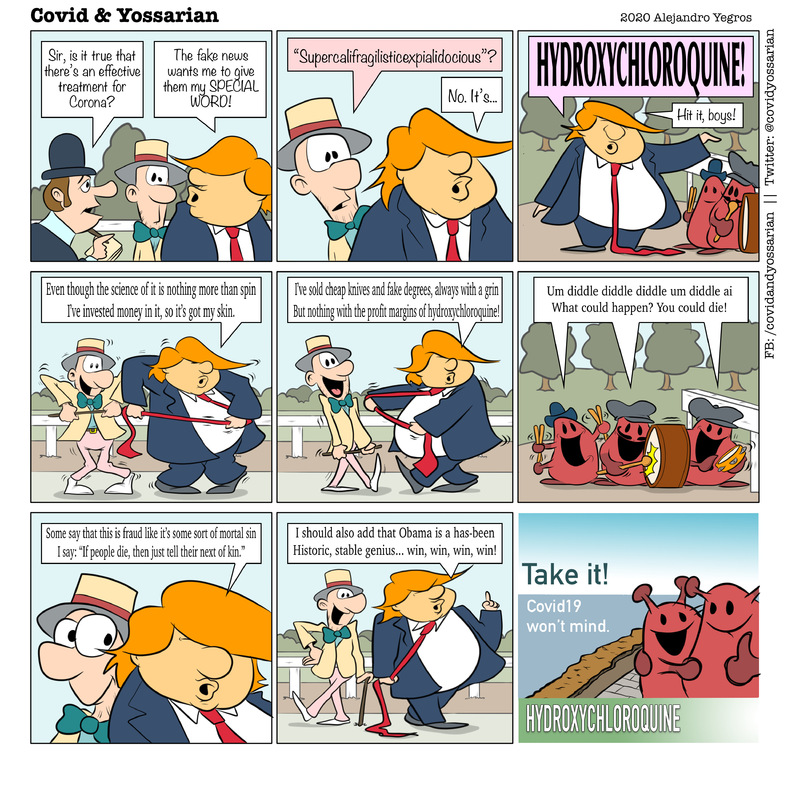
2020-05-24
A comic strip about Covid-19
-
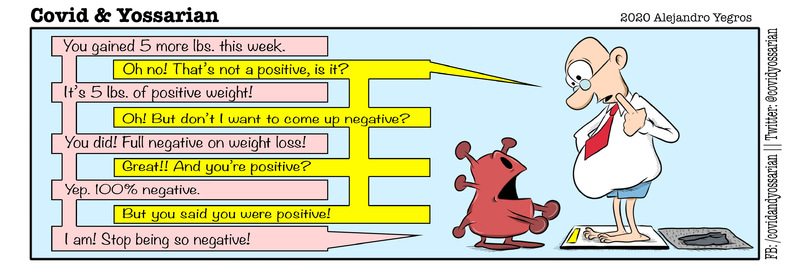
2020-05-23
A comic strip about Covid-19
-
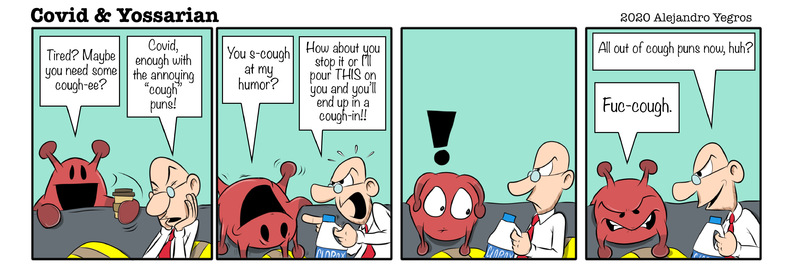
2020-05-22
A comic strip about Covid-19
-

2020-01
This is day by day account of the early stages of the pandemic.
-
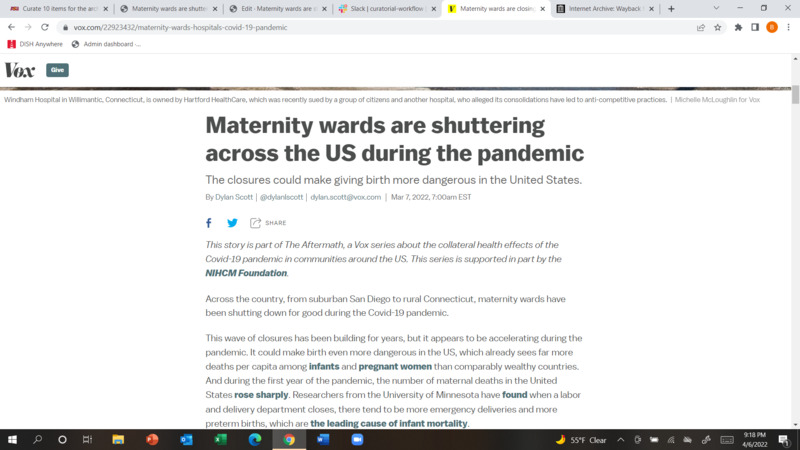
2022-03-07
This is a news story from Vox, written by Dylan Scott. Across the nation, maternity wards have been shutting down, making things more dangerous for new mothers. Due to these closures, there has been an increased number in deaths of both infants and pregnant women. These losses of maternity wards have been harshest on those of low income, as well as Black and Hispanic women. Part of these closures have happened due to shortages of doctors, nurses, and other hospital staff during the pandemic. The closure of more maternity wards also means women having to travel further to get the care they need. The timing makes this even more difficult during labor, as complications can happen during that, increasing chances of death. Overall, this article shows the ways that the ripple effects from COVID not only affect the mortality rates of mothers and babies, but disproportionately hurt poor, Black, and Hispanic women.
-
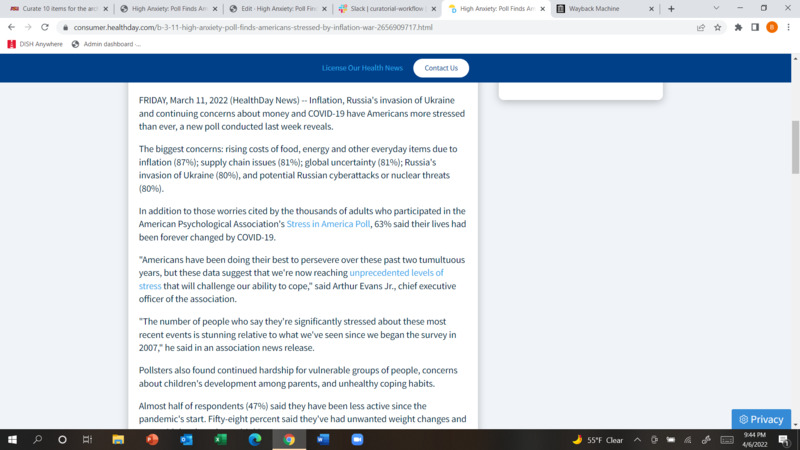
2022-03-11
This is a news story from Health Day by Robert Preidt. This is about a poll on what is making Americans most anxious. War, COVID-19, and inflation are at the top of what is making Americans feel anxious. Another thing the poll tells is that 63% percent said their lives changed forever due to COVID-19. 47% of people that took this poll also said that they have become less active compared to pre-pandemic. 58% said they had unwanted weight changes. Among those that gained more weight than they wanted, the average weight gain reported was 26 pounds. Others have said that the separation from others has put strain on relationships, or ended them. The APA reports that those with reduced social support are more likely to cope with stress. 56% say they could have used more emotional support during the pandemic. This poll had 3,012 respondents in February, and 2,051 from March 1-3.
-
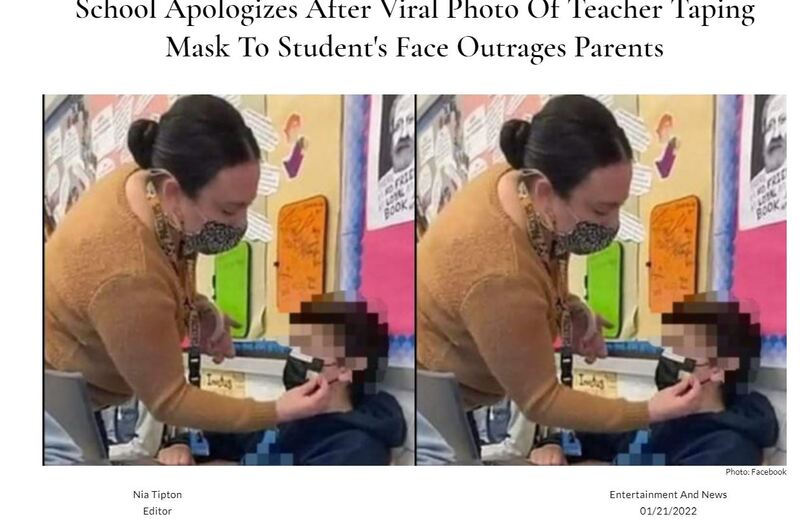
2022-01-21
This is a news story from Your Tango by Nia Tipton. This is about a middle school in Pennsylvania, where a video of a teacher taping a mask to a student caused outrage. The photo was taken at Pennfield Middle School in Hatfield. The photo went viral and appeared on Sean Hannity's website. The middle school announced that they are going to conduct an investigation over this scandal. Parents also expressed their anger at school board meetings over this. The mother of the student getting his mask taped to his face says that she never intended for the story to go viral. She used the photo to gain support from a Facebook group prior to a school board meeting. She says that other individuals in the group took it upon themselves to spread this story further.
-
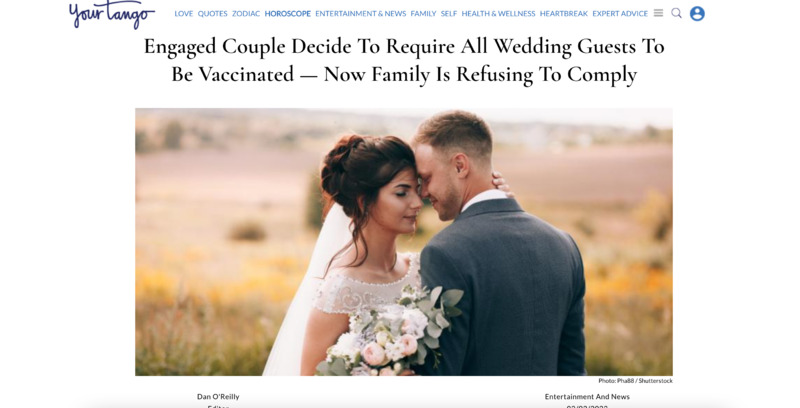
2022-02-02
This is a news story from Your Tango by Dan O'Reilly. This is about a couple that required all family members attending their wedding to be vaccinated. The issue with this is that the family does not want to comply to those wishes. This story was originally found in r/wedding on Reddit. According to the bride, her fiancé's family was on board with imposing vaccines, but the bride's own family is 50% vaccinated, with the unvaccinated thinking this is a dumb idea. This has been part of a controversial issue on if vaccines should be imposed. Most of the Redditors had sympathies for the engaged couple and believe it is what was needed for a safe event.
-

2022-02-17
This is a news story from Your Tango by Isaac Serna-Diez. This is about a Twitter rant, where Elon Musk, owner of Tesla, compares Prime Minister Justin Trudeau to Adolf Hitler over the Canadian Trucker Protests. In January, both the United States and Canada imposed vaccine mandates. According to the American Trucking Association, only 50-60% of all truckers are vaccinated. The truckers have created a convoy that blocks traffic across the US-Canada border in response to the mandates. Trudeau's response to this was to invoke the Emergencies Act, which has't been used since 1988. The Emergencies Act allows for freezing of bank accounts and funds in order to take money away from those protesting. These freezes would also impact things like GoFundMe and the ability to raise funds from that site. It also allows for military involvement, but Trudeau says that he has no plans of doing so. Musk's response to what Trudeau imposed economically on protesters prompted him to promote cryptocurrency more.
-
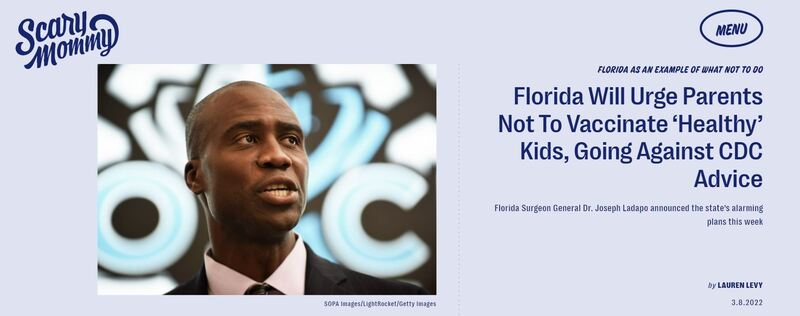
2022-03-08
This is a news story from Scary Mommy, written by Lauren Levy. This story deals with Florida's position on vaccinating children and going against CDC guidelines. The author, Levy, is very against this and thinks it is irresponsible to be contrary to what the CDC suggests, claiming that it will make things more dangerous for kids if they don't take the vaccine. Some have been raising concerns that people are taking politicians words over those of doctors. Opponents have reminded parents that this is just a suggestion from Florida politicians, and not a mandate, meaning that they can discern for themselves if the vaccine is right for their kids. Ultimately, Levy believes parents should ignore what Florida politicians say and listen to doctors instead on what to do.
-
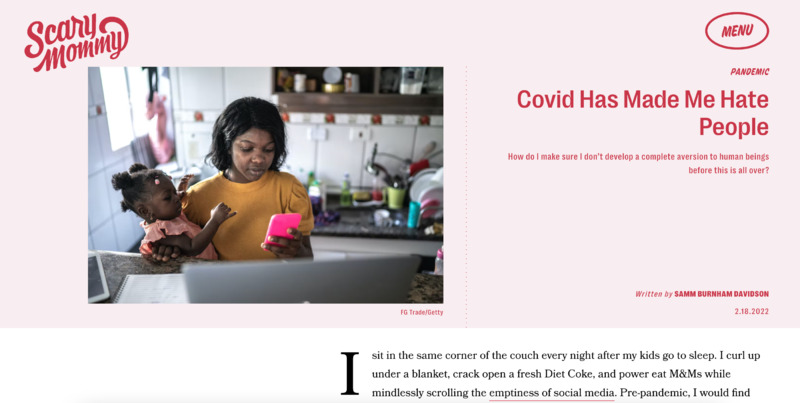
2022-02-18
This is a news story from Scary Mommy by Samm Burnham Davidson. This is a story written from the point-of-view of someone who has experienced some of the negative social effects of COVID. She says that before the pandemic, social media posts that annoyed her would only be mildly so, but with COVID and lockdowns, she started to feel senses of inadequacy compared to other parents. She thought that she needed to overhaul her entire wardrobe, her son should get ice skates, and that her four-year-old needs to learn to ride a two-wheeler bike. She has three young kids, and a 2020 baby. She describes feeling very isolated and the exposure to social media made her feel like she had to measure up to some imaginary standard of parenting, like trying to forgo all plastic toys for Christmas to help the environment. This is a good story for the perspective of mothers with many kids to take care of, resulting in even more isolation than what would happen for adults with no kids, as kids caused her to stay home more even before COVID.
-
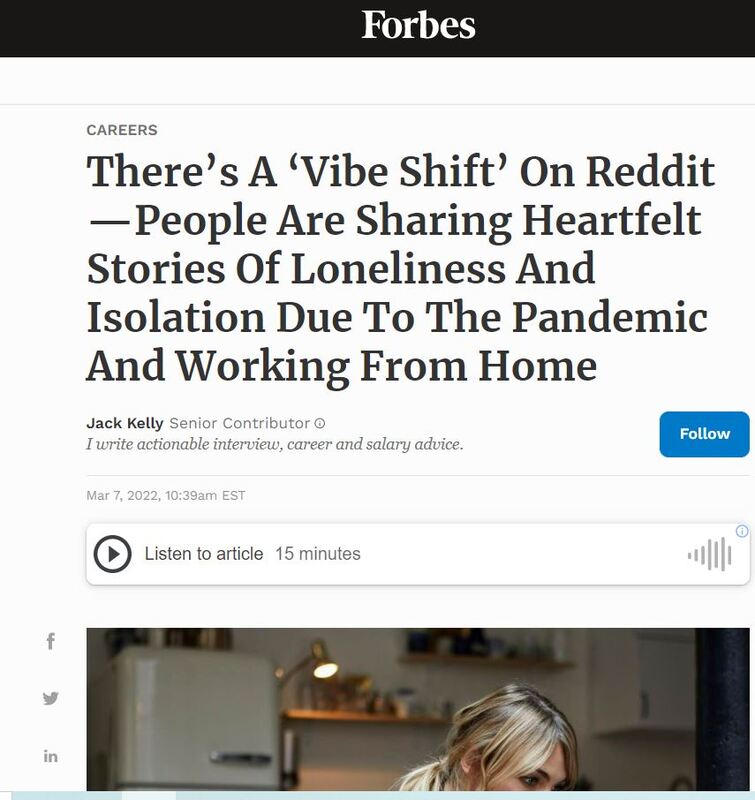
2022-03-07
This is a news story from Forbes by Jack Kelly. This story is about loneliness felt from isolation that people are discussing on Reddit. Subreddits like r/antiwork and r/wallstreetbets, a lot of these conversations are sharing details about their feelings they might not want to share elsewhere. Since Reddit allows people to submit anonymously, it gives others an environment they can give more details on subjects they maybe wouldn't tell to even their family members. Some of these discussions are about those that are single and work from home, which creates a very solitary experience. One woman, 27, on Reddit describes trying to join Facebook groups and do online dating to have more interaction during the pandemic. She says she felt a slight panic seeing her other friends get married, have kids, or engaged, which made her feel even lonelier. Others describe the challenges with finding remote work and needing support to help cope with that hardship. The lack of socialization has had massive effect on young adults just starting out in life, and it has given some worse mental health as a result. While some might thrive with being alone, others have suffered. Another woman, 32, says that prior to the pandemic, she was a 'social butterfly' and outgoing, but is now antisocial and a shut-in. She says that she lacks the motivation to go places like she used to. In addition to this, her place of employment is considering permanent work-from-home for employees, making some of those social struggles even worse. Some Redditors ended up giving advice for people that shared stories like these, such as smiling every day towards someone, or going outside for 15 minutes or longer. Simple things like this were common suggestions to help with some people's mental health issues induced because of the pandemic isolation. I think that this story helps show some of the negative effects young people have had with readjusting their entire lives, and then feeling lost once they get too used to it when things are starting to go back to "normal."
-
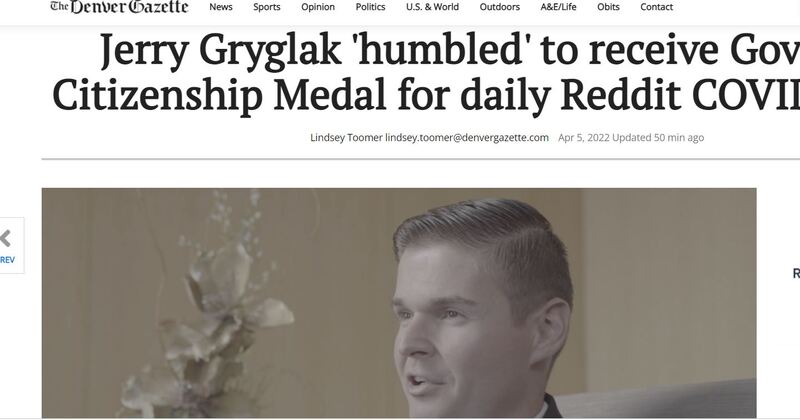
2022-04-05
This is a news story from The Denver Gazette by Lindsey Toomer. Since June 2020, Jerry Gryglak has posted COVID updates on the subreddit r/CoronavirusColorado, and breaking down the information to be more user-friendly. This has helped Redditors get better information on the virus. Due to his diligence, Governor Jared Polis is recognizing Gryglak as one of Colorado's COVID Heroes and will get the Governor's Citizenship Medal. Gryglak left posts on Reddit with updates on deaths, hospitalizations, vaccines, and other such information. Gryglak is unsure how much longer he will be posting these updates.
-
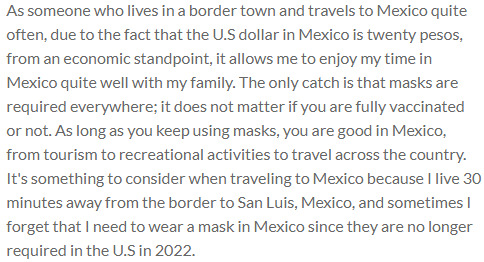
2022-04-05
As someone who lives in a border town and travels to Mexico quite often, due to the fact that the U.S dollar in Mexico is twenty pesos, from an economic standpoint, it allows me to enjoy my time in Mexico quite well with my family. The only catch is that masks are required everywhere; it does not matter if you are fully vaccinated or not. As long as you keep using masks, you are good in Mexico, from tourism to recreational activities to travel across the country. It's something to consider when traveling to Mexico because I live 30 minutes away from the border to San Luis, Mexico, and sometimes I forget that I need to wear a mask in Mexico since they are no longer required in the U.S in 2022.
-
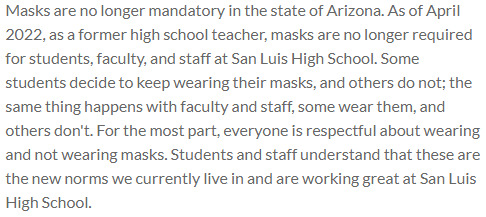
2022-04-05
Masks are no longer mandatory in the state of Arizona. As of April 2022, as a former high school teacher, masks are no longer required for students, faculty, and staff at San Luis High School. Some students decide to keep wearing their masks, and others do not; the same thing happens with faculty and staff, some wear them, and others don't. For the most part, everyone is respectful about wearing and not wearing masks. Students and staff understand that these are the new norms we currently live in and are working great at San Luis High School.
-
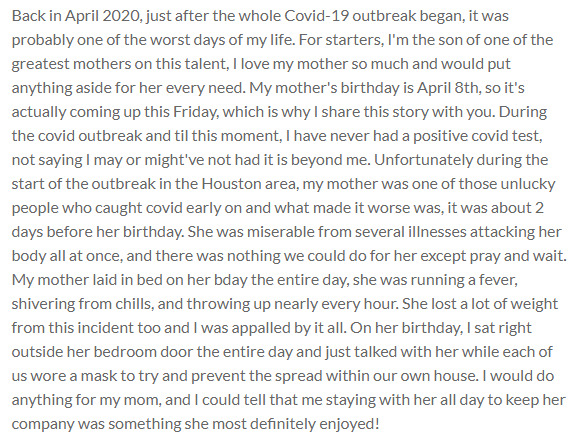
2020-04-08
Back in April 2020, just after the whole Covid-19 outbreak began, it was probably one of the worst days of my life. For starters, I'm the son of one of the greatest mothers on this talent, I love my mother so much and would put anything aside for her every need. My mother's birthday is April 8th, so it's actually coming up this Friday, which is why I share this story with you. During the covid outbreak and til this moment, I have never had a positive covid test, not saying I may or might've not had it is beyond me. Unfortunately during the start of the outbreak in the Houston area, my mother was one of those unlucky people who caught covid early on and what made it worse was, it was about 2 days before her birthday. She was miserable from several illnesses attacking her body all at once, and there was nothing we could do for her except pray and wait. My mother laid in bed on her bday the entire day, she was running a fever, shivering from chills, and throwing up nearly every hour. She lost a lot of weight from this incident too and I was appalled by it all. On her birthday, I sat right outside her bedroom door the entire day and just talked with her while each of us wore a mask to try and prevent the spread within our own house. I would do anything for my mom, and I could tell that me staying with her all day to keep her company was something she most definitely enjoyed!
-
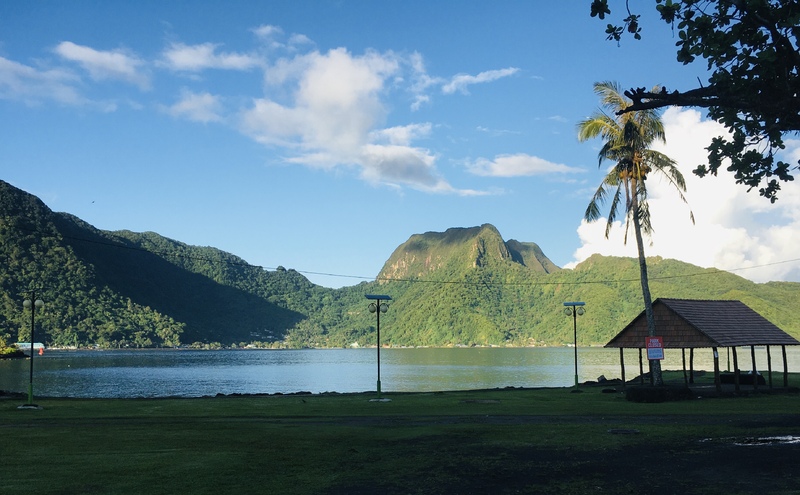
2022-04-05
At the "heart" of Polynesia, (referring to its geographic location in the Polynesian triangle) American Samoa appears as another tiny dot on the map. Nevertheless, it means the WORLD to its 55,000+ people, and to some, it is all they have ever known as their home. It is also the southernmost territory of the United States (below the Equator) and the second to the last place on earth to always welcome the New Year LAST. Perhaps it coincidently depicts the slow-paced nature of the island to which many visitors claim that "it feels like time slows down", here at a piece of heaven on earth that is deeply rooted in the Christian faith and the "Fa'aSamoa", a.k.a the Samoan culture or literally, the "Samoan way of life".
The people of our island are like a big tight-knitted family--we are all related anyway--when something good or bad happens on the west side of the island, news travels to the east faster or about the same as the speed of light! It has its disadvantages, but for the most part, it is a beautiful thing to see the collective reaction of our people when it is of happiness, support, and sympathy.
When the coronavirus started spreading rapidly in the United States in early 2020, our territory continued its commercial flights until mid-March when Hawaii's cases started to rise. Since March 2020, our borders were closed to commercial travel for the next 11 months, not including cargo flights and ships. Residents were stuck in the States for nearly a year. The first of many repatriation flights finally began in February 2021. The repatriation flights took place once a month, during which passengers would undergo a strict process of testing and reporting, a quarantined stay in Hawaii for 12 days, and another 2-weeks quarantine upon arrival in American Samoa. Throughout all repatriation and medical flights, the quarantine process was still a requirement, which was how positive cases were caught and taken care of to prevent community spread. Fast forward to February 2022, exactly a year later, news of a COVID outbreak quickly spread when it was leaked on social media that the family of a Department of Health worker tested positive for COVID at the main hospital. The general public was seeking answers and taking their concerns on social media until later on that same evening the said family tested positive, the local news channel held a Livestream in which the Governor, Lieutenant Governor, and the COVID-19 Task Force officially announced the community outbreak of the virus. People rushed to the stores to buy necessities and food before the lockdown was set to begin at midnight. The lockdown was marked as Code Red, with curfews from 9pm to 4:30 am, and business hours to be from 8am to 4pm, while all government workers and non-essential employees are to stay home, except essential workers and first-responders. Students transitioned to virtual learning and now interact in class with options such as "raise hand" and/or "mute/unmute".
Our people had to adjust very quickly to the new reality we now face. A small island once free with family gatherings, church services, and close human interaction as we are known for...now all of that sounds like a distant memory that will take some time to experience again. Beaches and parks used to be crowded with people and all the happiness they offer their surroundings, now empty and eerily quiet with a "CLOSED" sign nearby. We are masking up everywhere--with little to no physical interaction--so far with 4,700+ cumulative positive cases and a total loss of 7 souls, which has hit our dearest island with extreme sorrow. While the world has moved forward and learned to live with COVID, even opening back up and unmasking, our island is once again a little behind with the experience. It is only the beginning for us! Fortunately, our unwavering faith in God continues to be our ultimate Hope, along with the support of our loving families, beloved people, the United States, and our fellow Pacific islands. One thing we are sure of is that WE ARE RESILIENT PEOPLE, having overcome many challenges for centuries! This too shall pass...on the bright side, in order for it to pass, our journey with COVID had to begin. Now we must go through it, endure it, and overcome together AS one like we always do! God be with us...God IS with us.
-
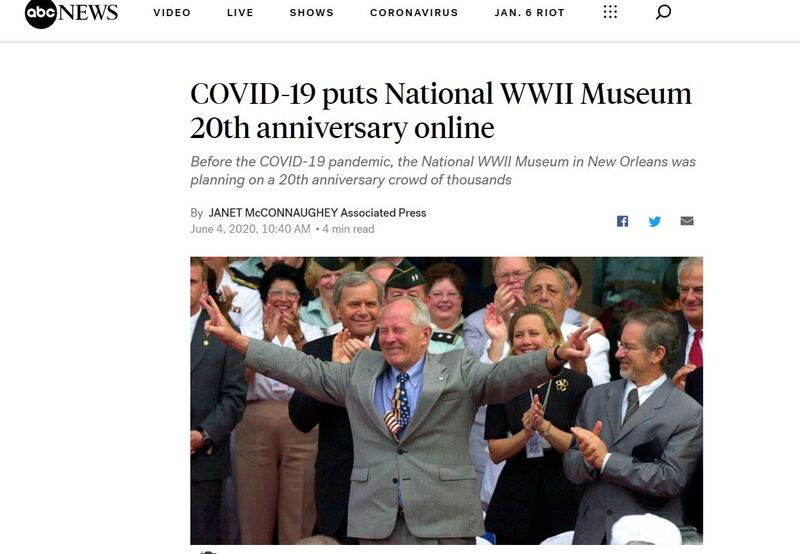
2020-06-04
This article details the holding of the 20th anniversary of the opening of the National WWII Museum in New Orleans on June 4th 2020. This is significant because thousands of people were supposed to attend, but now had to watch the ceremonies online as a result of the spread of COVID-19. This is an interesting contribution to the museum collection of the archive not only because the size of this event, but due to the fact that there are few military history museums mentioned in the archives. This is important to me as someone who studies military history, and because I was one of the many people spectating this ceremony online.
-

2022-01-19
This article discusses the closure of the Smithsonian National Postal Museum in Washington D.C in January of 2022. This is significant due to the fact that its closure is a result of staffing shortages, which have been affecting museums all over the country during the COVID-19 pandemic. This is a significant contribution to the archives because museums do not have a lot of representation within the archives, especially postal museums. The article is important to me personally because I was able to visit there once while I was in Washington D.C., and it was an interesting experience.
-
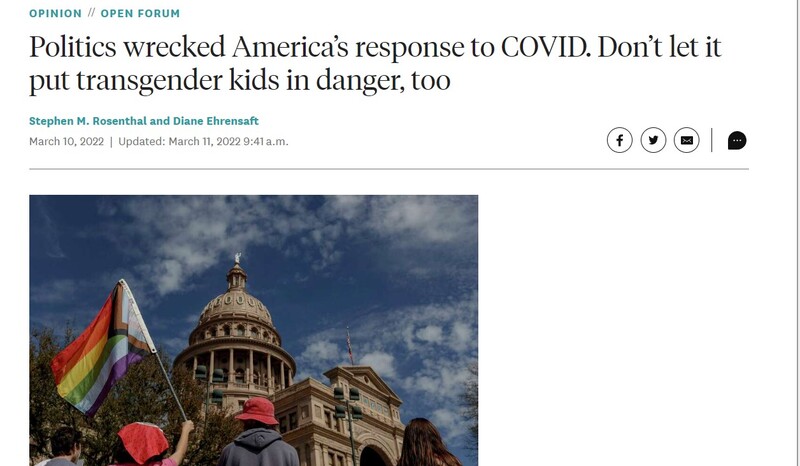
2022-03-10
This is a news story from The San Francisco Chronicle, written by Stephen M. Rosenthal and Diane Ehrensaft. This is an opinion piece comparing the government response to COVID and the politics surrounding it to ruining the response. The authors warn that following politics over science is dangerous. It later goes on to talk about the anti-trans legislation being passed through different states, such as: Idaho, Texas, and Florida. The authors believe that science proves that trans kids have no real threat from puberty blockers. A study is also quoted, where it says that gender affirming care for trans youth is linked to lower instances of depression. The point of this article is not so much about COVID itself, but fear of what was done during the peak of COVID being repeated on other types of legislation, and in this case, using politics over science with trans kids.
-
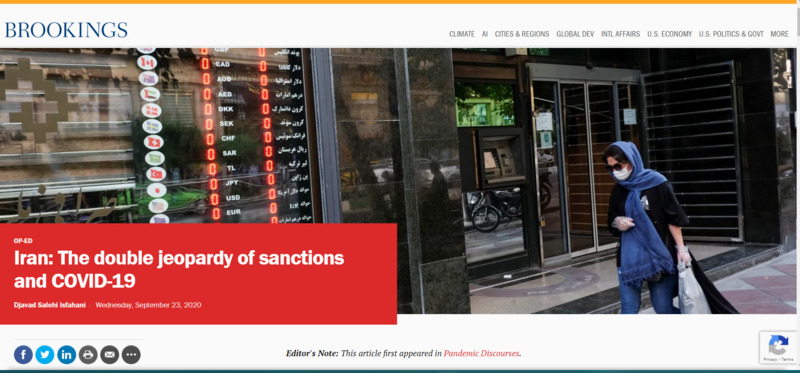
2020-09-23
This article discusses the effects of Covid-19 on Iran and how the sanctions imposed on Iran by the Trump administration exacerbated Covid’s effect on Iran’s already weak economy. It highlights Iran’s attempts to reduce the fatality rate despite a shortage of medical supplies. Additionally, the article posits that lifting sanctions during the pandemic might have reduced the death toll by thousands. While there is speculation that the true number of Covid deaths in Iran has been reduced and even misreported, this article highlights the connection between U.S. politics and the effects of sanctions imposed on countries during a public health crisis.
-
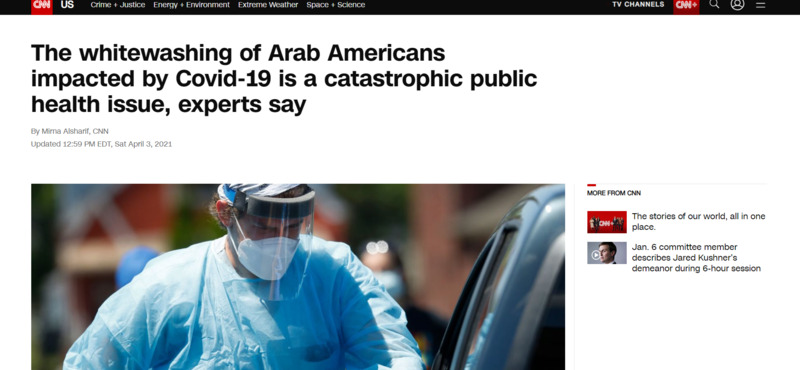
2021-04-03
This article brings up important points regarding the underrepresentation of Middle Eastern and North African (MENA) people and communities in U.S. This article focuses primarily on Arab Americans, but also sheds light on the fact that there are no identifiers for Middle Eastern and North African people on the U.S. Census as their only options are to choose “white” or “other”. As a result, there is a lack of Covid-19 data specific to these communities which prevents support and information being directed to those underrepresented – and often socioeconomically underprivileged – groups. This article is important in demonstrating the vulnerability of this group. Many MENA families live in multi-generational homes, have preexisting medical conditions or risk factors which may make them more vulnerable should they contract Covid, and still some do not have access to the information and support needed to prevent Covid or to receive the proper treatment if infected. Additionally, because MENA people are not able to self-identify on the U.S. Census, the information about how these communities are being affected is not accurate. The U.S. Census isn’t the only place where these identifiers do not exist. Job, scholarship, and college applications (to name only a few) do not provide accurate identifiers for MENA individuals. I think this article is important in revealing the lack of identifiers available to MENA people and how important it is that this is changed soon.
-
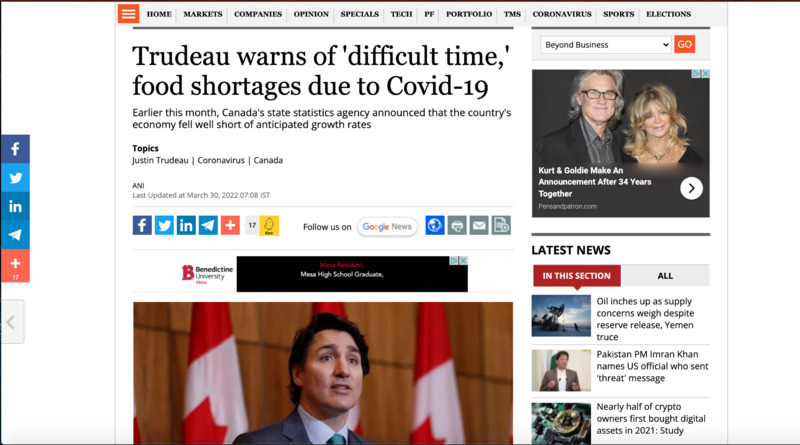
2022-03-30
This is a news story from the Business Standard. This is about the after effects of COVID on the Canadian population. Prime Minister Justin Trudeau warns that it will be a difficult time with food shortages due to COVID. Some of the blame for the food shortages is also placed on Russia's invasion of Ukraine. Similar tactics of blaming President Vladimir Putin for the rising prices of goods has also been used by President Joe Biden. The global disruption of supply chains results in higher prices of necessities. Earlier in March, the Canadian government announced that the economy fell short of its anticipated growth for that month. In February, inflation in Canada rose by 5.7%, the highest increase since August 1991.
-
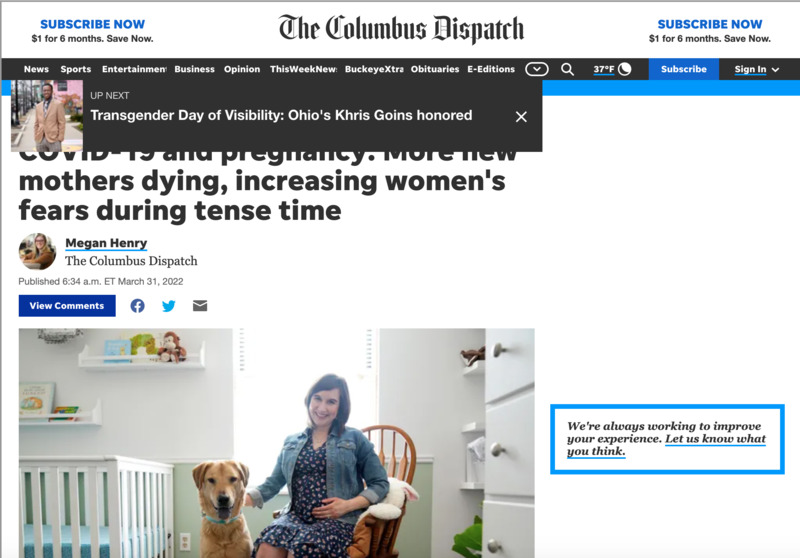
2022-03-31
This is a news story from The Columbus Dispatch by Megan Henry. This story is about the rising fears of new mothers as COVID has increased their chances of dying. In 2020, motherhood mortality rate increased by 20% in the United States. There were also large disparities in who died, with Black women dying three times the rate of White women during pregnancy. Dr. Jason Melillo, an OB-GYN for OhioHealth claims that COVID is the main culprit for the rise in pregnancy related deaths. Pregnant women are more prone to complications from COVID, with things such as blood clots, stillbirth, and preeclampsia happening more often. This concern has made some couples only deciding on pregnancy until they have both been vaccinated. Dr. Melillo hopes that over time, mortality rates associated with pregnant women will go down.
-
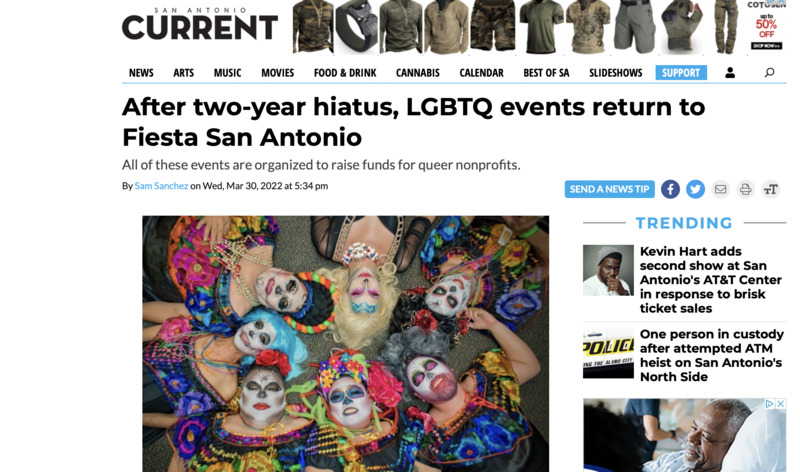
2022-03-30
This is a news story from the San Antonio Current by Sam Sanchez. This story is about LGBTQ events returning to San Antonio after a two year break due to COVID. For the past two years, many of these events have been canceled. This article shares events happening in San Antonio and what non-profits they benefit. Some of these non-profits include: the San Antonio AIDS Foundation, The Thrive Youth Center, Pride San Antonio and BEAT AIDS. Events include: themed parties, chili cook-offs, party shuttles, and fiestas. Certain events include fees for attending and certain COVID precautions, such as masks, to attend.
-
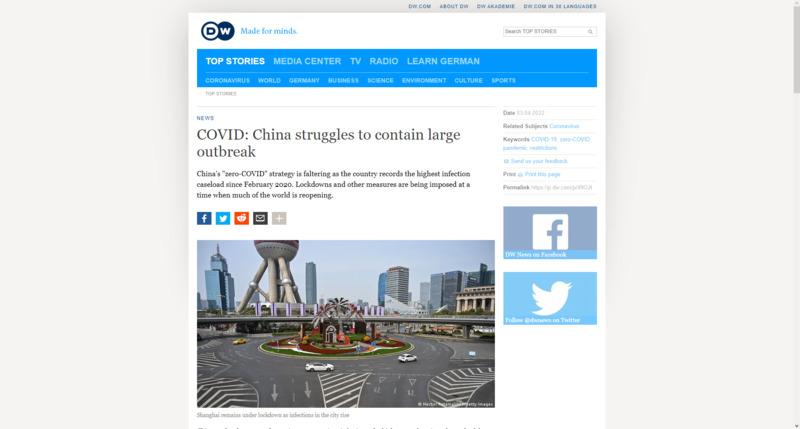
2022-04-03
This is a news story by DW News. It is a story about how the outbreak of COVID has not been very well controlled in China, with China reporting 13,146 new cases, the most since the beginning of the pandemic in 2020. Despite these numbers, the Chinese government has claimed that there have been no new deaths despite the high number of infections. Shanghai is the worst affected region in China, in which as city of 25 million has been under lockdown. Vice President Sun Chunlan, who is on the Communist Party's Politburo claims that swift actions taken will help stop the spread of the virus. In Beijing, there have been lockdowns, mass testing, and travel restrictions placed on the populace. Residents of Shanghai are worried about the lockdowns exceeding four days, as it will limit their ability to obtain fresh food. Parents also fear being separated from their children for too long under strict quarantine. The article mentions Xi being in tough spot with this too, as these lockdowns will have an ill effect on an already fragile economic situation.
-
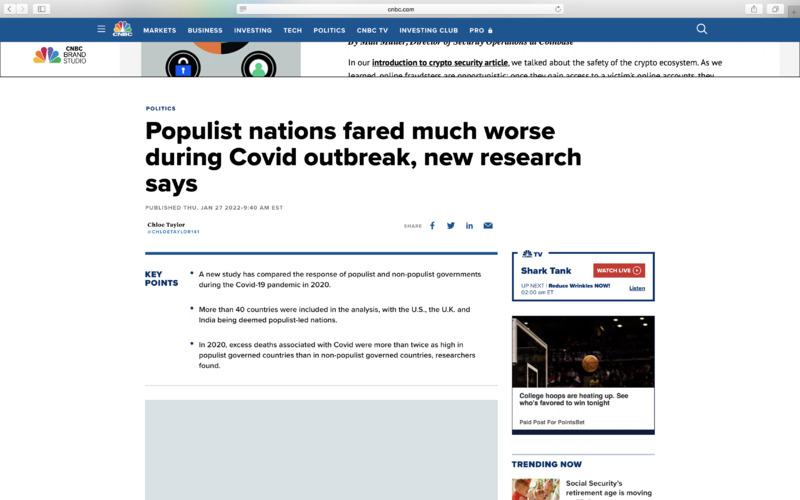
2022-01-27
This is a news story from CNBC, written by Chloe Taylor. This is a story about a study that came out about how well populist nations fared under COVID-19 compared to other nations around the world. More than 40 countries were included in this study, with the US, UK, and India being considered populist nations at the time that this was conducted. In 2020, the study claims that excess deaths were more than twice as high for populist ran governments. For comparison, the countries that were not considered populist in this study include Canada, Sweden, and Japan. For every 100 COVID related deaths, non-populist countries had an additional 8 deaths. In populist led countries, it was an additional 18 deaths for every 100 deaths. The study attributes this to higher citizen mobility that was allowed in populist nations, leading to more spread of the virus. It also claims that populist governments downplayed the severity of the virus itself, giving people the impression that things were safer than they actually were.
-
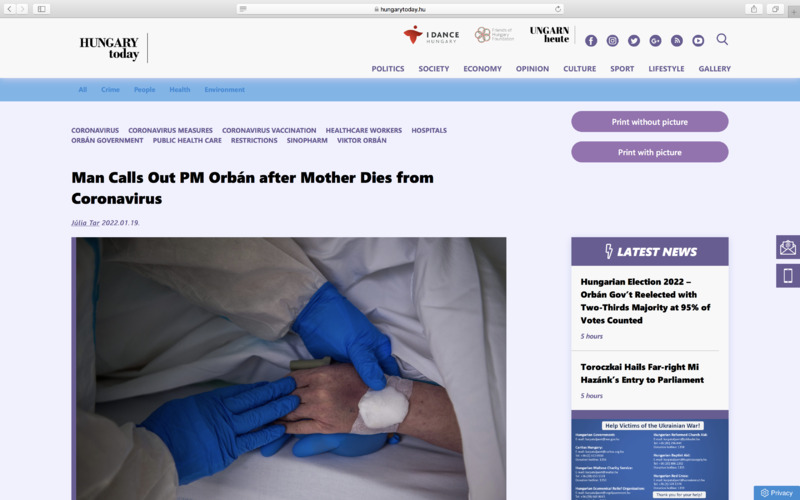
2022-01-19
This is a news story from Hungary Today by Júlia Tar. A man's mother and sister from Nagykanizsa both died from the Coronavirus. Later, this man calls out Prime Minister Viktor Orbán because he believes PM Orbán did not properly protect his family. His mother was vaccinated with Sinopharm, a Chinese vaccine. The PM himself received Sinopharm as his first two doses, with Moderna as his third dose. The man describes feeling hurt seeing his mother die in the hospital after she contracted the Coronavirus.
-
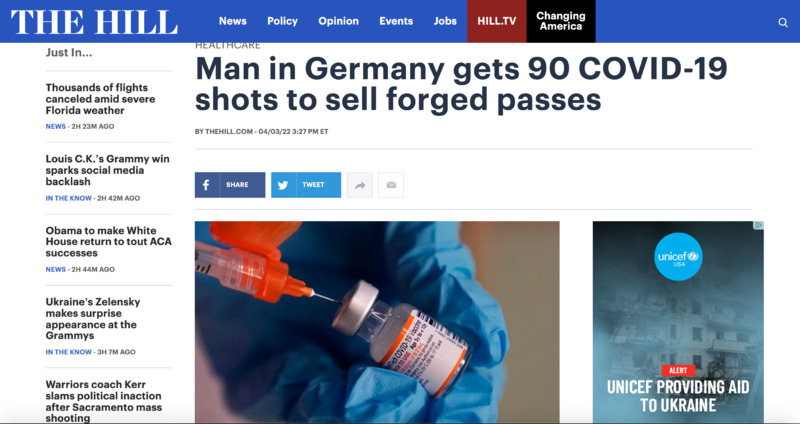
2022-04-03
This is a story by The Hill about a German man from Magdeburg getting the COVID vaccines a copious amount of times in order to make forged vaccine cards. The man in question is 60 years old and was caught in Eilenburg in Saxony. The article states that we do not know what effects will happen after getting the vaccine 90 times. The German government has been trying to crack down on forgeries of vaccine cards. This probably speaks of a bigger nationwide issue, where people will want forgeries if forced to get the vaccines that they see as against their will. With that, brings people like this man who will get the vaccine many times in order to make money off of selling forged vaccine cards.
-
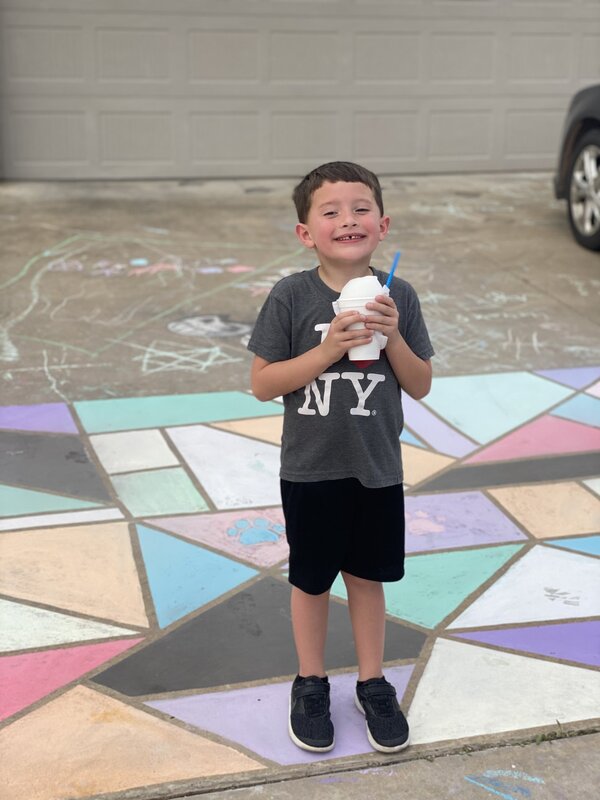
2020-04-08
A few weeks into quarantine our neighborhood decided to decorate all the sidewalks and driveways with sidewalk chalk. This was a great way for the kids of the neighborhood to express themselves and feel a sense of togetherness, even though they were all apart. With the use of the neighborhood Facebook group, we were able to coordinate times for the kids to go around and check out all the cool sidewalk art and leave messages for their friends to read. This really made my son feel like part of something, as a kindergartener he was just getting used to being in school, and then after Spring Break he was not able to return to class and we had to get creative. This neighborhood art project was a bright spot in a very difficult and uncertain time.
-
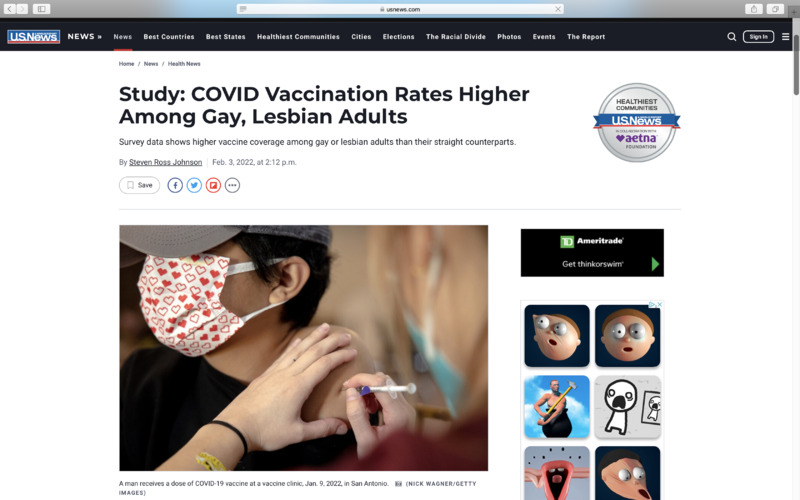
2022-02-03
This is a news story for US News by Steven Ross Johnson. This story is about a study on how LGBTQ+ people are more likely to have been vaccinated compared to the general population. In a survey published by the CDC, 85% of gay and lesbian adults received at least one dose of the COVID vaccine compared to just 76% of heterosexual adults. Within the LGBTQ+ community, gay men had the highest vaccination rates at 89%, compared to 81% of women. Nearly 76% of trans and nonbinary adults report having had at least one dose. This study also noted income disparities among LGBTQ+ adults. Those with a $75K income or above and LGBTQ+ had a 94% vaccination rate. For those LGBTQ+ adults below poverty level, the vaccination rate was 74%. Along racial lines, White LGBTQ+ individuals had a 92% vaccination rate. Black LGBTQ+ adults reported vaccination rates of 67%. Overall, this article shows that LGBTQ+ individuals are more likely to have less vaccine hesitancy compared to the general population, though income and race make a difference when those elements are combined.
-
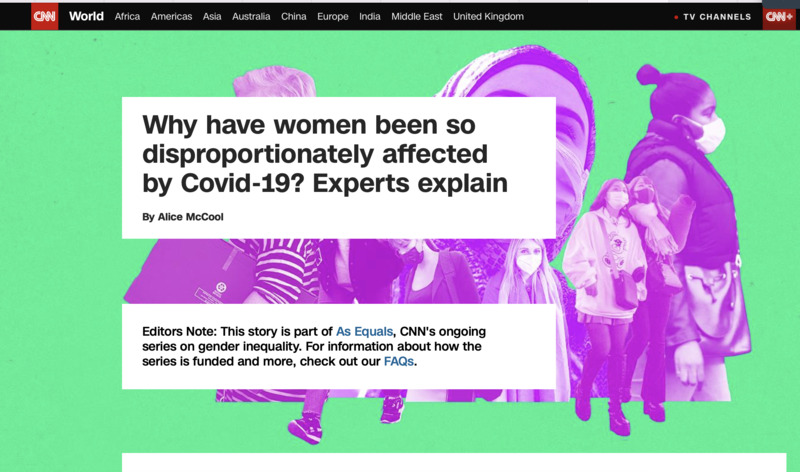
2022-03-10
This is a news story from CNN by Alice McCool. This story talks about the inequalities women have faced during COVID-19. In a CNN poll, women in the G7 countries (US, UK, France, Germany, Canada, Japan, and Italy) felt less supported by their leaders than men did. Some of these inequalities include women being more likely to lose their jobs or take on more uncompensated care work. Other things, such as abortion services, were considered non-essential in some countries during COVID. Minority women and poor women were also more likely to work low-paying jobs and bear much of the economic strain. Additionally, trans healthcare was also viewed as non-essential in many places. In places like Uganda, many women lost their safety net provided from schools, resulting in rising teen pregnancies and early marriages. This article continues showing more examples of the hoops women had to jump through compared to men and demonstrates the social issues that got worse as a result from COVID lockdowns.
-
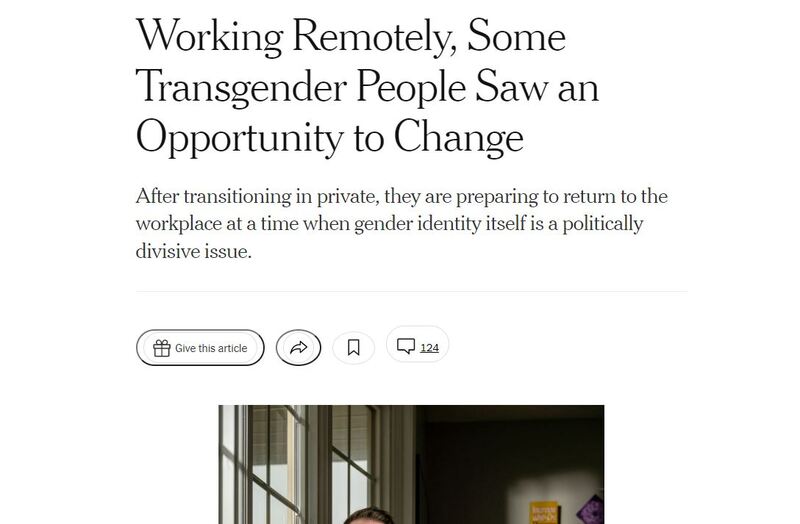
2022-03-17
This is a news story from the New York Times by Jenny Gross and Alyssa Lukpat. This story is about people that have transitioned during COVID, or before that, and their work experiences. Some of the data present is interesting to look at. In 2021, healthcare providers reported a stronger demand for confirmation surgeries compared to 2020 when many elective surgeries were postponed. Though, demand was even higher in 2021 compared to 2019, before the pandemic. Some doctors say that this influx is partly due to surgeries being postponed, but there are other explanations. At Mount Sinai Hospital in New York City, the Center for Transgender medicine and surgery performed a total of 938 surgeries in 2021, 60 percent more than the previous year, and 43 percent higher than 2019. While there is this influx, the story links to a YouGov poll showing that many Americans are still divided on if others should be legally allowed to switch their sex. The article then goes on to discuss other inequalities trans people face, such as earning 32 percent less than the general population. Trans people are also twice as likely to be unemployed compared to the general population.
Later on, there is a discussion on what trans people face in the workforce. Even in more liberal and progressive work environments, some trans people still report feeling unsafe working in person. There are complaints that diversity training in the workplace focuses mainly on gays, but glosses over trans people and their issues. Other trans people, like Rae Lee, fears she will be fired if she came out to public administrators. Working from home has allowed Rae Lee to feel safer.
-
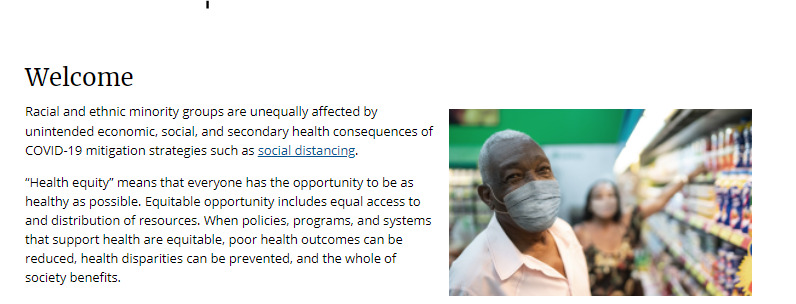
2020-12-10
CDC page outlining racial disparity in the transmission and treatment of COVID-19. There are explanations given for the discrepancies pertaining to economic disparity as well. This illustrates the knowledge of the discrepancies in the transmission of COVID-19 across different racial backgrounds and social classes and possible solutions.
-

2020-12-03
Warner Bros. announces its intentions to simultaneously release its films in theaters and on its streaming service, HBO Max. This illustrates the changes in business practices that film studios have had to consider due to the pandemic’s effect on the theater industry and audiences’ willingness to go see movies in theaters at this time. This decision would be a somewhat controversial one as filmmakers gave polarizing reactions to their films being released this way.
 2020-06-08
2020-06-08 2020-06-07
2020-06-07 2020-06-06
2020-06-06 2020-06-05
2020-06-05 2020-06-04
2020-06-04 2020-05-03
2020-05-03 2020-06-02
2020-06-02 2020-06-01
2020-06-01 2020-05-31
2020-05-31 2020-05-30
2020-05-30 2020-05-29
2020-05-29 2020-05-28
2020-05-28 2020-05-27
2020-05-27 2020-05-26
2020-05-26 2020-05-25
2020-05-25 2020-05-24
2020-05-24 2020-05-23
2020-05-23 2020-05-22
2020-05-22 2020-01
2020-01 2022-03-07
2022-03-07 2022-03-11
2022-03-11 2022-01-21
2022-01-21 2022-02-02
2022-02-02 2022-02-17
2022-02-17 2022-03-08
2022-03-08 2022-02-18
2022-02-18 2022-03-07
2022-03-07 2022-04-05
2022-04-05 2022-04-05
2022-04-05 2022-04-05
2022-04-05 2020-04-08
2020-04-08 2022-04-05
2022-04-05 2020-06-04
2020-06-04 2022-01-19
2022-01-19 2022-03-10
2022-03-10 2020-09-23
2020-09-23 2021-04-03
2021-04-03 2022-03-30
2022-03-30 2022-03-31
2022-03-31 2022-03-30
2022-03-30 2022-04-03
2022-04-03 2022-01-27
2022-01-27 2022-01-19
2022-01-19 2022-04-03
2022-04-03 2020-04-08
2020-04-08 2022-02-03
2022-02-03 2022-03-10
2022-03-10 2022-03-17
2022-03-17 2020-12-10
2020-12-10 2020-12-03
2020-12-03